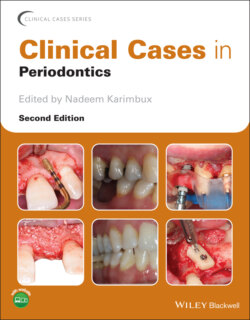Читать книгу Clinical Cases in Periodontics - Группа авторов - Страница 86
Discussion
ОглавлениеFollowing the 2017 World Workshop on the Classification of Periodontal and Peri‐implant Diseases and Conditions, the previous classification of chronic periodontitis and aggressive periodontitis was amended so that now they are grouped under a single category – “periodontitis” [1]. With the new 2017 classification system, grading estimates the aggressiveness of the disease by focusing on the factors contributing to progression rather than previously focusing on the identification of a form of periodontitis. The characteristic clinical and radiographic features associated with molar/incisor pattern periodontitis allow the oral healthcare provider to diagnose the condition without much difficulty. The case that we present in this book chapter exhibited the classical clinical and radiographic features of molar/incisor pattern periodontitis, including age of onset of disease, the pattern of disease progression and aggressiveness in clinical attachment loss. Stage III was determined after considering both severity (including interdental attachment loss ≥5 mm and bone loss beyond more than middle third of root) and complexity (including probing depths ≥6 mm with vertical bone loss ≥3 mm). Grade C was due to the high risk of progression. Therefore a diagnosis of molar/incisor pattern stage III grade C periodontitis was made. In some cases, microbiological and immunological tests can be used as an adjunct to diagnose this disease. Increased levels of Aggregatibacter actinomycetemcomitans (especially serotype b) microbes and a robust antibiotic response to the same microorganism are expected in such testing. After completing phase 1 therapy consisting of scaling and root planing with adjunctive use of systemic antibiotics, a drastic improvement in probing depth reduction and clinical attachment gain are expected in deeper pockets. Residual pockets (>6 mm) remaining after phase 1 therapy will be usually treated with surgical periodontal therapy. Adequate oral hygiene is critical in the successful outcome of any periodontal therapy. Usually patients with molar/incisor pattern periodontitis tend to exhibit insignificant amounts of local factors such as plaque and calculus and tend to have good oral hygiene. In the case described in this chapter, the patient had insignificant amounts of local factors (Figures 1.5.1–1.5.5). With respect to outcomes of surgeries performed in patients with molar/incisor pattern periodontitis, long‐term stability after regenerative therapy has been shown. The success rates of dental implants in patients with molar/incisor pattern periodontitis are inconclusive. Some studies have indicated that the success rates in these patients are slightly lower (<10%) than in patients with grade A or B periodontitis [2,3].
